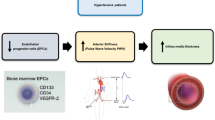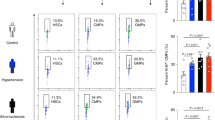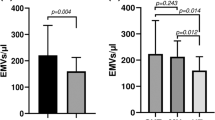Abstract
Prehypertension is associated with significant damage to the coronary vasculature and increased rates of adverse cardiovascular events. Circulating endothelial progenitor cells (EPCs) are critical to vascular repair and the formation of new blood vessels. We tested the hypothesis that prehypertension is associated with EPC dysfunction. Peripheral blood samples were collected from 83 middle-aged and older adults (51 male and 32 female): 40 normotensive subjects (age 53±2 years; BP 111/74±1/1 mm Hg) and 43 prehypertensive subjects (age 54±2 years; 128/77±1/1 mm Hg). EPCs were isolated from peripheral blood, and EPC colony-forming capacity (colony-forming unit (CFU) assay), migratory activity (Boyden chamber) and apoptotic susceptibility (active caspase-3 concentrations) were determined. There were no significant differences in the number of EPC CFUs (10±2 vs 9±1), EPC migration (1165±82 vs 1120±84 fluorescent units) or active intracellular caspase-3 concentrations (2.7±0.3 vs 2.3±0.2 ng ml−1) between the normotensive and prehypertensive groups. When groups were stratified into low prehypertension (n=27; systolic blood pressure: 120–129 mm Hg) and high prehypertension (n=16; 130–139 mm Hg), it was found that EPCs from the high prehypertensive group produced fewer (∼65%, P<0.05) CFUs compared with the low prehypertensive (4±1 vs 12±2) and normotensive adults. In conclusion, EPC colony-forming capacity is impaired only in prehypertensive adults with systolic BP greater than 130 mm Hg. Prehypertension is not associated with migratory dysfunction or enhanced apoptosis of EPCs.
This is a preview of subscription content, access via your institution
Access options
Subscribe to this journal
Receive 12 digital issues and online access to articles
$119.00 per year
only $9.92 per issue
Buy this article
- Purchase on Springer Link
- Instant access to full article PDF
Prices may be subject to local taxes which are calculated during checkout


Similar content being viewed by others
References
Wang Y, Wang QJ . The prevalence of prehypertension and hypertension among US adults according to the new joint national committee guidelines: new challenges of the old problem. Arch Intern Med 2004; 164 (19): 2126–2134.
Qureshi AI, Suri MF, Kirmani JF, Divani AA, Mohammad Y . Is prehypertension a risk factor for cardiovascular diseases? Stroke 2005; 36 (9): 1859–1863.
Erdogan D, Caliskan M, Yildirim I, Gullu H, Baycan S, Ciftci O et al. Effects of normal blood pressure, prehypertension and hypertension on left ventricular diastolic function and aortic elastic properties. Blood Press 2007; 16 (2): 114–121.
Knight EL, Kramer HM, Curhan GC . High-normal blood pressure and microalbuminuria. Am J Kidney Dis 2003; 41 (3): 588–595.
Dimmeler S, Zeiher AM . Vascular repair by circulating endothelial progenitor cells: the missing link in atherosclerosis? J Mol Med 2004; 82 (10): 671–677.
Asahara T, Masuda H, Takahashi T, Kalka C, Pastore C, Silver M et al. Bone marrow origin of endothelial progenitor cells responsible for postnatal vasculogenesis in physiological and pathological neovascularization. Circ Res 1999; 85 (3): 221–228.
Assmus B, Schachinger V, Teupe C, Britten M, Lehmann R, Dobert N et al. Transplantation of progenitor cells and regeneration enhancement in acute myocardial infarction (TOPCARE-AMI). Circulation 2002; 106 (24): 3009–3017.
Kunz GA, Liang G, Cuculi F, Gregg D, Vata KC, Shaw LK et al. Circulating endothelial progenitor cells predict coronary artery disease severity. Am Heart J 2006; 152 (1): 190–195.
Vasa M, Fichtlscherer S, Aicher A, Adler K, Urbich C, Martin H et al. Number and migratory activity of circulating endothelial progenitor cells inversely correlate with risk factors for coronary artery disease. Circ Res 2001; 89 (1): E1–E7.
Werner N, Kosiol S, Schiegl T, Ahlers P, Walenta K, Link A et al. Circulating endothelial progenitor cells and cardiovascular outcomes. N Engl J Med 2005; 353 (10): 999–1007.
Chobanian AV, Bakris GL, Black HR, Cushman WC, Green LA, Izzo Jr JL et al. The Seventh Report of the Joint National Committee on Prevention, Detection, Evaluation, and Treatment of High Blood Pressure: the JNC 7 report. JAMA 2003; 289 (19): 2560–2572.
Lohman T, Roche A, Mortorell R . Anthropometric Standardization Reference Manual. Human Kinetics: Champaign, IL, 1988.
DeSouza CA, Shapiro LF, Clevenger CM, Dinenno FA, Monahan KD, Tanaka H et al. Regular aerobic exercise prevents and restores age-related declines in endothelium-dependent vasodilation in healthy men. Circulation 2000; 102: 1351–1357.
MacEneaney OJ, Kushner EJ, Van Guilder GP, Greiner JJ, Stauffer BL, DeSouza CA . Endothelial progenitor cell number and colony-forming capacity in overweight and obese adults. Int J Obes (Lond) 2009; 33 (2): 219–225.
Hoetzer GL, MacEneaney OJ, Irmiger HM, Keith R, Van Guilder GP, Stauffer BL et al. Gender differences in circulating endothelial progenitor cell colony-forming capacity and migratory activity in middle-aged adults. Am J Cardiol 2007; 99 (1): 46–48.
Chobanian AV . Prehypertension revisited. Hypertension 2006; 48 (5): 812–814.
Gu Q, Burt VL, Paulose-Ram R, Yoon S, Gillum RF . High blood pressure and cardiovascular disease mortality risk among U.S. adults: the third National Health and Nutrition Examination Survey mortality follow-up study. Ann Epidemiol 2008; 18 (4): 302–309.
Vasan RS, Larson MG, Leip EP, Evans JC, O'Donnell CJ, Kannel WB et al. Impact of high-normal blood pressure on the risk of cardiovascular disease. N Engl J Med 2001; 345 (18): 1291–1297.
Imanishi T, Moriwaki C, Hano T, Nishio I . Endothelial progenitor cell senescence is accelerated in both experimental hypertensive rats and patients with essential hypertension. J Hypertens 2005; 23 (10): 1831–1837.
Hill JM, Zalos G, Halcox JP, Schenke WH, Waclawiw MA, Quyyumi AA et al. Circulating endothelial progenitor cells, vascular function, and cardiovascular risk. N Engl J Med 2003; 348 (7): 593–600.
Delva P, Degan M, Vallerio P, Arosio E, Minuz P, Amen G et al. Endothelial progenitor cells in patients with essential hypertension. J Hypertens 2007; 25 (1): 127–132.
Stamler J, Stamler R, Neaton JD . Blood pressure, systolic and diastolic, and cardiovascular risks. US population data. Arch Intern Med 1993; 153 (5): 598–615.
He J, Whelton PK . Elevated systolic blood pressure and risk of cardiovascular and renal disease: overview of evidence from observational epidemiologic studies and randomized controlled trials. Am Heart J 1999; 138 (3 Part 2): 211–219.
Urbich C, Dimmeler S . Endothelial progenitor cells: characterization and role in vascular biology. Circ Res 2004; 95 (4): 343–353.
Britten MB, Abolmaali ND, Assmus B, Lehmann R, Honold J, Schmitt J et al. Infarct remodeling after intracoronary progenitor cell treatment in patients with acute myocardial infarction (TOPCARE-AMI): mechanistic insights from serial contrast-enhanced magnetic resonance imaging. Circulation 2003; 108 (18): 2212–2218.
Takahashi T, Kalka C, Masuda H, Chen D, Silver M, Kearney M et al. Ischemia- and cytokine-induced mobilization of bone marrow-derived endothelial progenitor cells for neovascularization. Nat Med 1999; 5 (4): 434–438.
Chrysohoou C, Panagiotakos DB, Pitsavos C, Skoumas J, Economou M, Papadimitriou L et al. The association between pre-hypertension status and oxidative stress markers related to atherosclerotic disease: the ATTICA study. Atherosclerosis 2007; 192 (1): 169–176.
Julius S, Nesbitt S, Egan B, Kaciroti N, Schork MA, Grozinski M et al. Trial of preventing hypertension: design and 2–year progress report. Hypertension 2004; 44 (2): 146–151.
Imanishi T, Hano T, Sawamura T, Nishio I . Oxidized low-density lipoprotein induces endothelial progenitor cell senescence, leading to cellular dysfunction. Clin Exp Pharmacol Physiol 2004; 31 (7): 407–413.
Imanishi T, Hano T, Nishio I . Angiotensin II accelerates endothelial progenitor cell senescence through induction of oxidative stress. J Hypertens 2005; 23 (1): 97–104.
Yu Y, Fukuda N, Yao EH, Matsumoto T, Kobayashi N, Suzuki R et al. Effects of an ARB on endothelial progenitor cell function and cardiovascular oxidation in hypertension. Am J Hypertens 2008; 21 (1): 72–77.
Ito H, Rovira II, Bloom ML, Takeda K, Ferrans VJ, Quyyumi AA et al. Endothelial progenitor cells as putative targets for angiostatin. Cancer Res 1999; 59 (23): 5875–5877.
Hur J, Yang HM, Yoon CH, Lee CS, Park KW, Kim JH et al. Identification of a novel role of T cells in postnatal vasculogenesis: characterization of endothelial progenitor cell colonies. Circulation 2007; 116 (15): 1671–1682.
Asahara T, Takahashi T, Masuda H, Kalka C, Chen D, Iwaguro H et al. VEGF contributes to postnatal neovascularization by mobilizing bone marrow-derived endothelial progenitor cells. EMBO J 1999; 18 (14): 3964–3972.
Chade AR, Zhu X, Lavi R, Krier JD, Pislaru S, Simari RD et al. Endothelial progenitor cells restore renal function in chronic experimental renovascular disease. Circulation 2009; 119 (4): 547–557.
Acknowledgements
We would like to thank all the subjects who participated in the study, as well as Yoli Casas and Jeremy Stoner for their technical assistance. This study was supported by the National Institutes of Health Awards HL068030, DK062061, HL076434 and MO1 #RR00051.
Author information
Authors and Affiliations
Corresponding author
Ethics declarations
Competing interests
The authors declare no conflict of interest.
Rights and permissions
About this article
Cite this article
MacEneaney, O., DeSouza, C., Weil, B. et al. Prehypertension and endothelial progenitor cell function. J Hum Hypertens 25, 57–62 (2011). https://doi.org/10.1038/jhh.2010.31
Received:
Revised:
Accepted:
Published:
Issue Date:
DOI: https://doi.org/10.1038/jhh.2010.31
Keywords
This article is cited by
-
Role of endothelial colony forming cells (ECFCs) Tetrahydrobiopterin (BH4) in determining ECFCs functionality in coronary artery disease (CAD) patients
Scientific Reports (2022)
-
Fluid Shear Stress Ameliorates Prehypertension-Associated Decline in Endothelium-Reparative Potential of Early Endothelial Progenitor Cells
Journal of Cardiovascular Translational Research (2022)
-
Stage 1 hypertension, but not elevated blood pressure, predicts 10-year fatal and non-fatal CVD events in healthy adults: the ATTICA Study
Journal of Human Hypertension (2019)
-
Berberine-Promoted CXCR4 Expression Accelerates Endothelial Repair Capacity of Early Endothelial Progenitor Cells in Persons with Prehypertension
Chinese Journal of Integrative Medicine (2018)
-
Preference for salt contributes to sympathovagal imbalance in the genesis of prehypertension
European Journal of Clinical Nutrition (2013)



